


6. The Dutch call me gedachtestreep—a dash of thought.
BOEKS—opening
thursday 12.12.19
19:00 - 22:00
20:00—Figures for dashing
Performance with Stine Sampers,
Naomi Schatteman
& Mathilde Strijdonk
Speaker: Brian Day
20:30—Thoughts on dashing
Talk with Peter de Voogd & Astrid Seme
BOEKS—exhibition
13.12.2019 - 06.03.2020
BOEKS—reading group
05.03.2020, 20pm, Kunstenbibliotheek
Baroness Elsa’s em dashes
2019
design and concept by Astrid Seme
published by Mark Pezinger Books & Kunstverein Langenhagen
No.1 of the Black Forest Library
10 × 14.5 cm, 88pp,
English, edition: 400
The publication is for sale at Kunstenbibliotheek for €13.
Or in the BOEKS shop.
Published in connection with the exhibition "She Is The Future" in Kunstverein Langenhagen (09/12/18-03/02/19).
BOEKS 05:
Astrid Seme—Baroness Elsa’s em dashes
Baroness Elsa’s em dashes is an homage to the Dada artist and poet Elsa von Freytag-Loringhoven (1874 – 1927) and to her manic use of em dashes. Em dashes have different purposes—as an appropriation of silence, as acting dissonance, as interruption, as occupying space. In Elsa’s work, they seem to function more like performers between the words, creating movement and voice within the text. The exhibition places these performers in a real space, turning BOEKS into a performative venue.
Elsa’s em dashes will not just spread across the space, but they will become multiple voices inviting us to dash around. At the opening, the sound piece Figures for dashing will be interpreted by performers Stine Sampers, Naomi Schatteman and Mathilde Strijdonk. Afterwards, professor Emeritus of English Literature Peter de Voogd and graphic designer and sound artist Astrid Seme will try to put the dash into words. Together, we’ll send some Thoughts on Dashing into space.
Baroness Elsa’s em dashes is also the title of a book published in early 2019 by Kunstverein Langenhagen and Mark Pezinger Books, a Vienna & Black Forest-based publisher of artist’s books. They call it an anthology of dashing in print, poetry and performance. The reader will find Elsa’s works in conversation with well-known dashers such as Gertrude Stein, Laurence Sterne, Heinrich von Kleist or Emily “the dashing queen” Dickinson.




Alexandru Balgiu (Designing Writing) about Astrid Seme’s book Baroness Elsa’s em dashes:
A heart the thickness of a dash. I hold *Baroness Elsa’s em dashes* in my hand and hear the ticking of the Teke Heart. Elsa von Freytag-Loringhoven’s superb 1921 piece on the Beating of Heart comes to mind like a dash of thought, as I feel the book. Reading Astrid Seme’s wonderful anthology of dashing in print, poetry & performance is indeed an experience of pulsations: as I browse through the pages, a school of dashes animate in a playful dance in front of my eyes. One swiftly understands that *Baroness Elsa’s em dashes* is not merely a collection, it is an invitation. And it is not merely an observation, but also a proposition. Or rather, a series of pages propositions — remindful of Wittgenstein’s Tractatus — as the page numbers have left their paratextual position to lead the order of discourse, becoming the numbering of enunciations. *Baroness Elsa’s em dashes* counts to 81. Normal resting heart rates range from 60-100 beats per minute. The gesture of turning the page is an em-phasis of the progression of thought and — like the em-dash — marks “an appropriation of silence”. Astrid’s voice, in turn, is at once analytical and personal, weaving the typographic and the poetic with openness and proximity. Through these dashing propositions she unveils intersections (perhaps these em-dashes are not all so parallel, after all?) and explores cross-readings that prove — brilliantly — that neither design nor literature are monological, one-way roads, but rather myriad modalities for apprehending the subtleties and complexities of existence. Through radiant anecdotes, quotations and moving details, Astrid establishes contact. We get in touch with Baroness Elsa and Emily (Dickinson), and Heinrich (von Kleist), and Christian (Morgenstern), and Gertrude (Stein), and Lawrence (Sterne)… and it is now up to us to engage conversation and extend the dash, no matter how perceptible the thickness of line. Infrathin em-dashes? In Emily’s words:
A Murmur in the Trees — to note —
Not loud enough — for Wind —
A Star — not far enough to seek —
Nor near enough — to find —
At this point, Astrid would perhaps invite us to take a breath, as she does periodically throughout her publication, addressing us and calling on our own consciousness of the moment.
I, in turn, will urge you to meet her beautiful book.
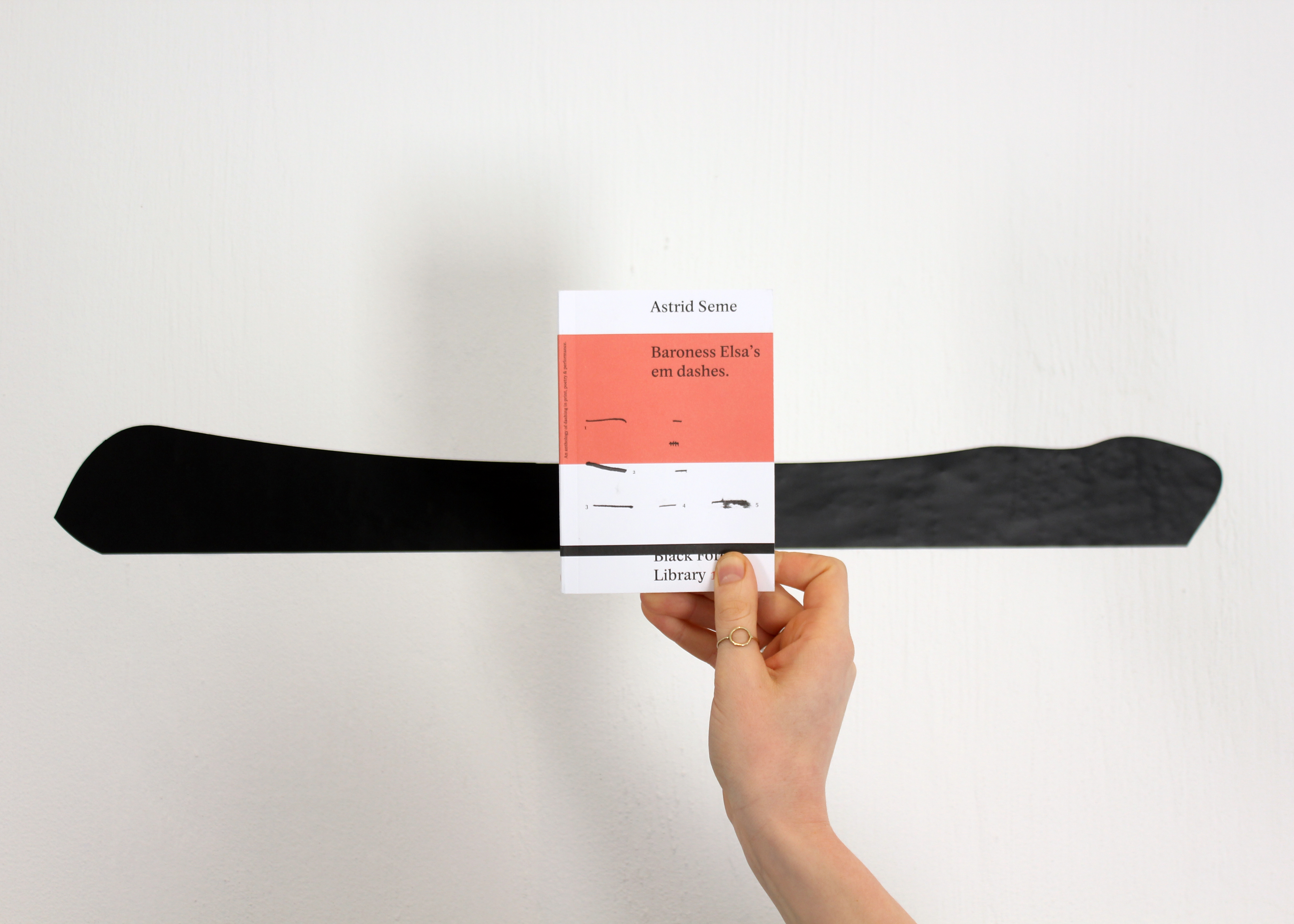
01
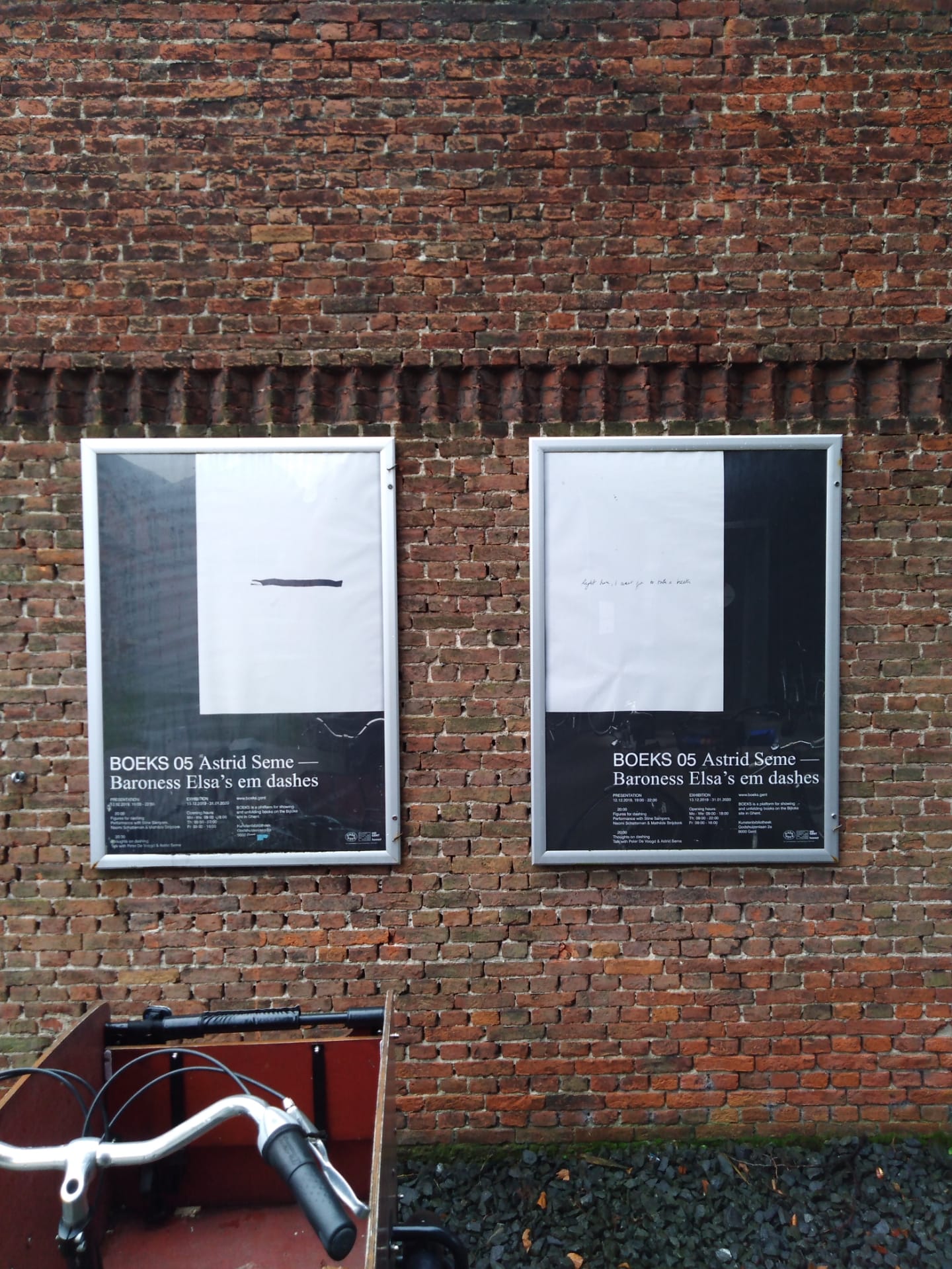
02
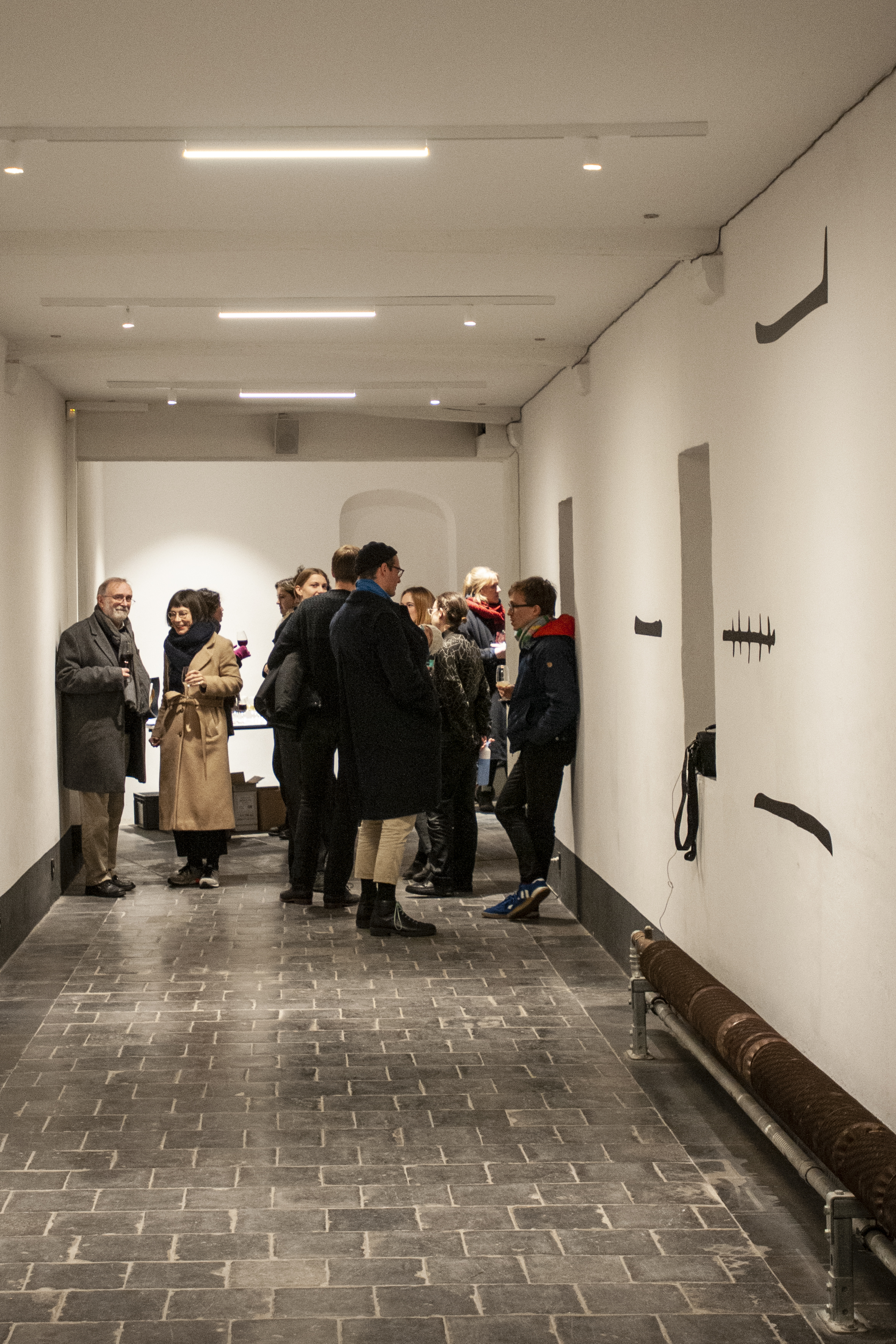
03

04

05
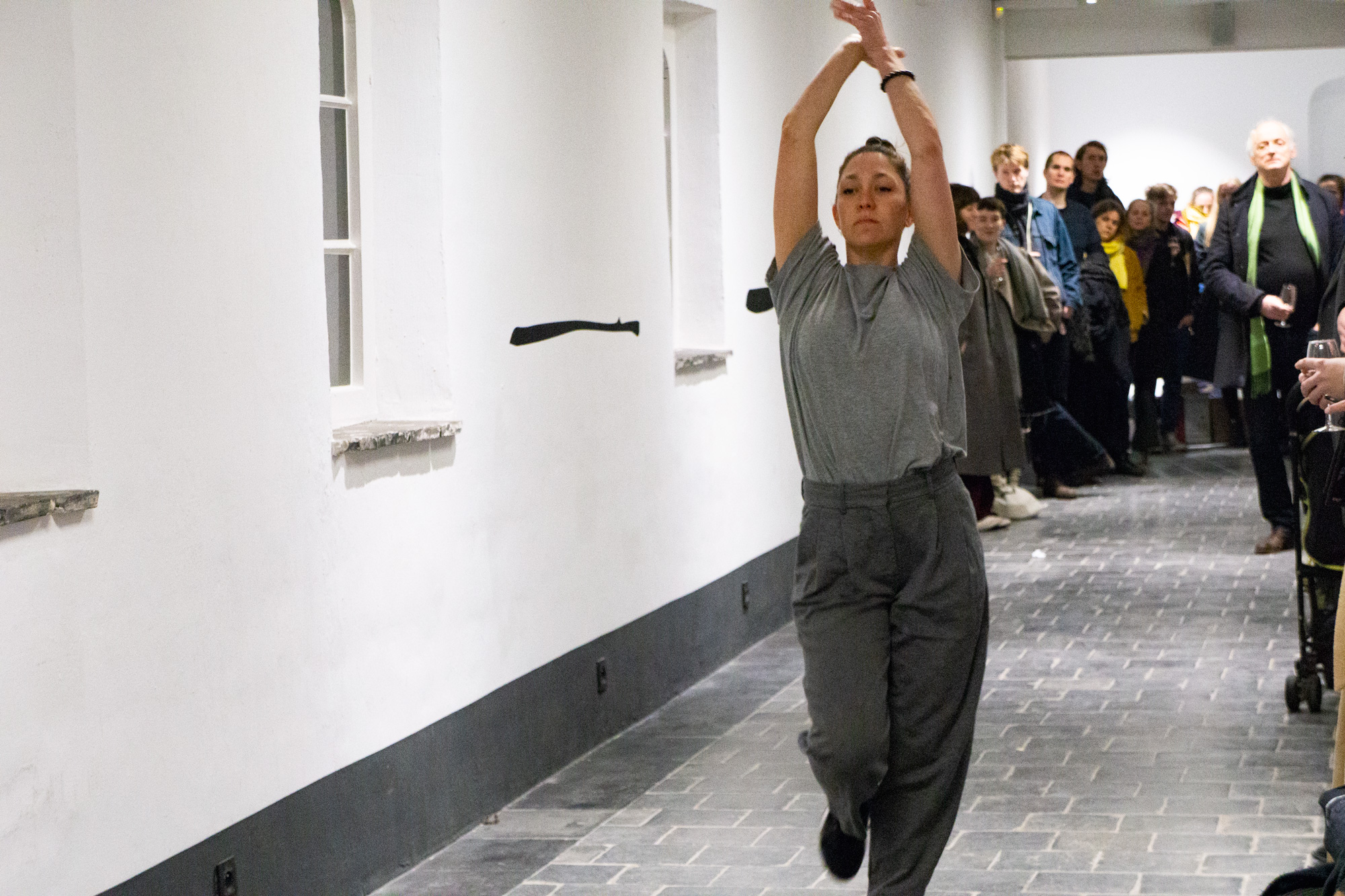
06

07

08
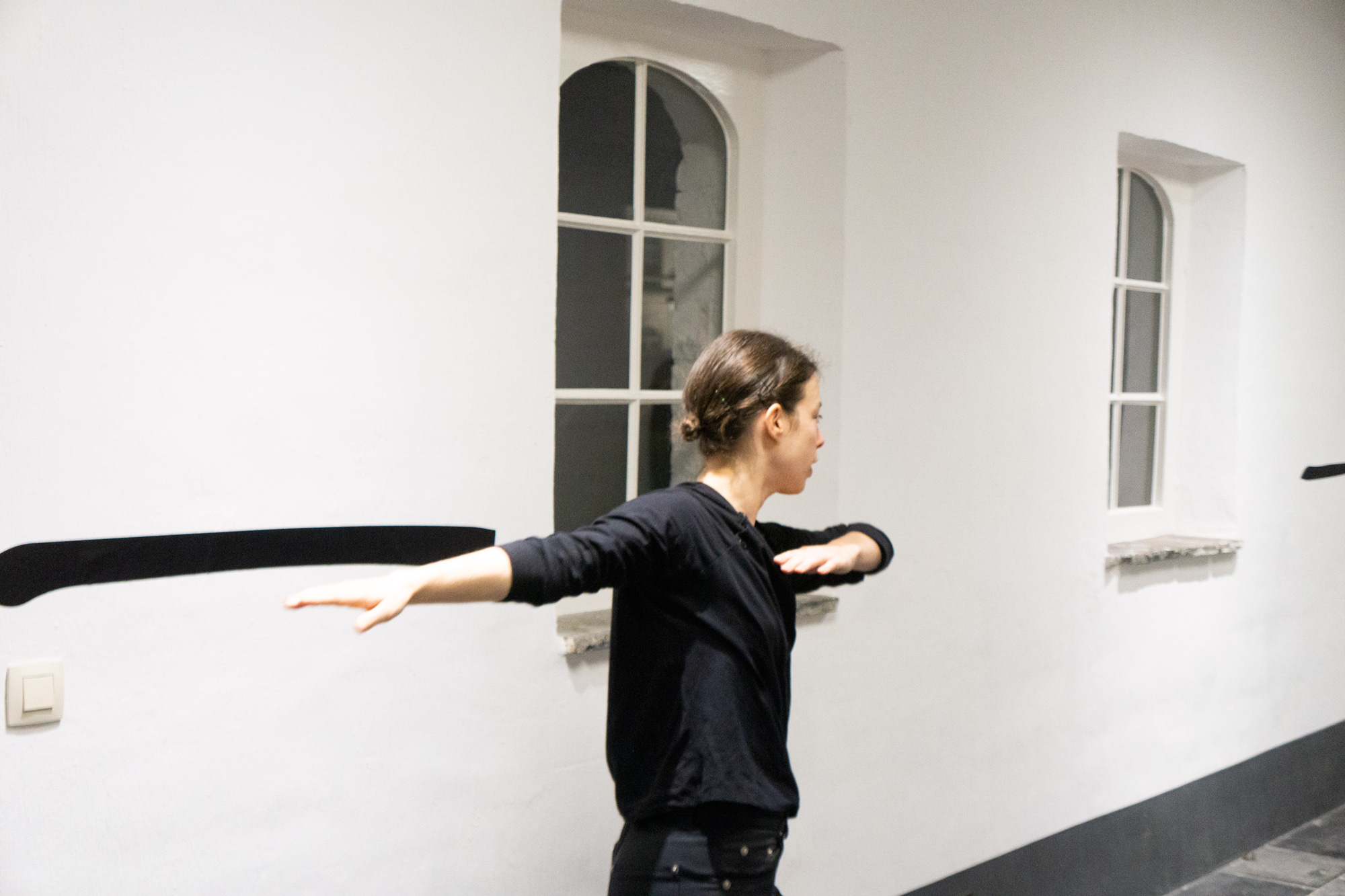
09


10
11
01 Barones Elsa’s em dashes—Astrid Seme. (2019, Mark Pezinger Books). Photo: Arno Huygens.
02 Poster Design BOEKS 05: Myrthe Van Rompaey. Photo: Veerle Vervliet.
03 Opening BOEKS 05: Astrid Seme—Baroness Elsa’s em dashes. Photo: Zoë De Bock.
04 Figures for dashing
—Performance with Stine Sampers,
Naomi Schatteman & Mathilde Strijdonk. Speaker: Brian Day. Photo: Zoë De Bock.
05 Figures for dashing.
06—07—08—09 Figures for dashing
—Performance with Stine Sampers,
Naomi Schatteman & Mathilde Strijdonk. Photo: Thomas Geiger.
10 BOEKS 05 collection on display in the Kunstenbibliotheek. Photo: Cato Vanrijckeghem.
11 Thoughts on dashing—Talk with Peter de Voogd & Astrid Seme. Video: Zoë De Bock.
12 BOEKS 05 corridor. Photo: Cato Vanrijckeghem.
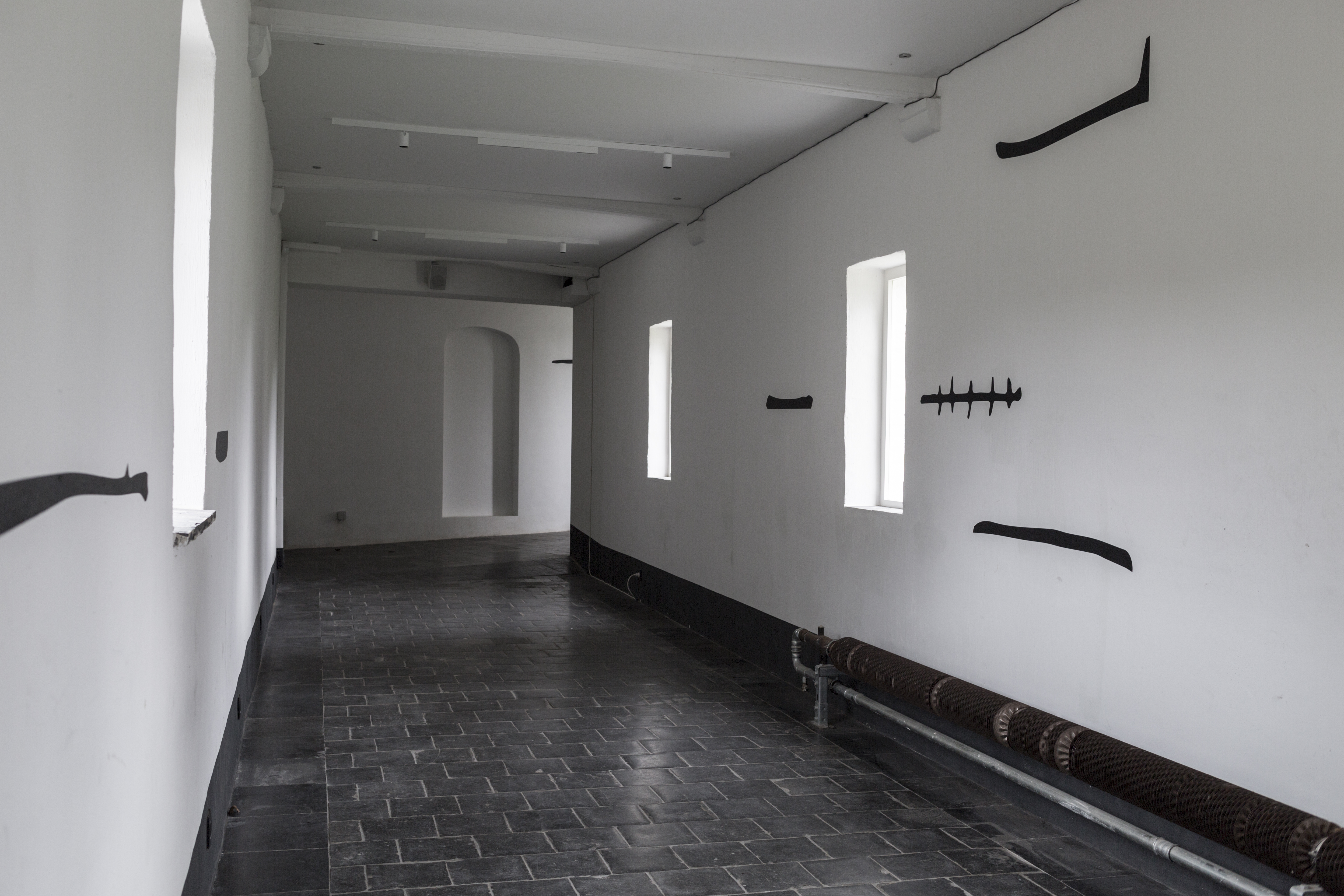
12

BOEKS reading group 03
mine soul—is
mine song to thee—
——thus its end
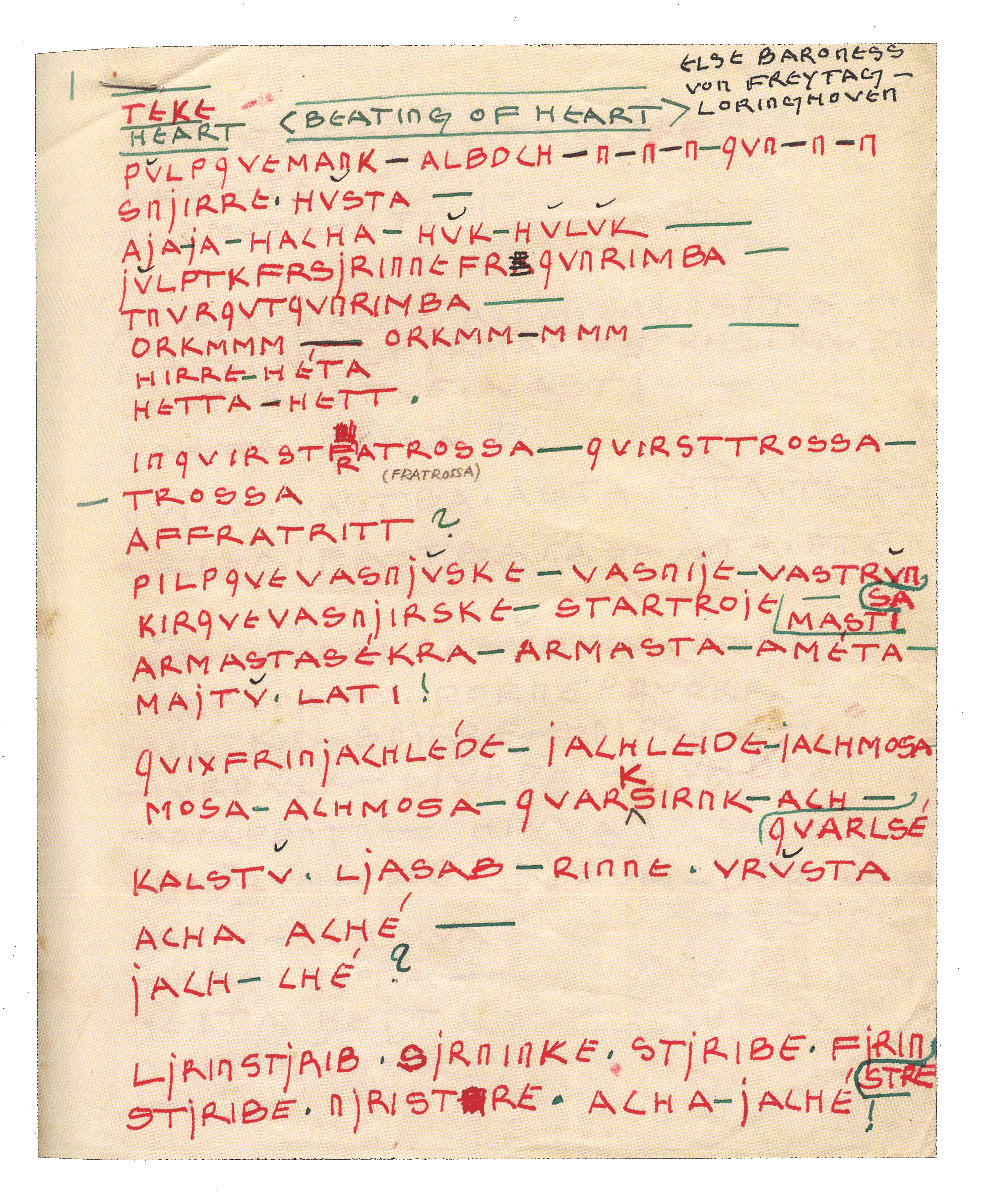
Teke Heart (Beating of Heart), ca 1921. Source: The Little Review Records, University of Wisconsin-Milwaukee Libraries.
Thursday March 5th at 20:00
Kunstenbibliotheek
With this reading group, titled after the last sentence of the poem Mineself—Minesoul—And—Mine—Cast—Iron Lover by the avant-garde artist and poet Elsa von Freytag-Loringhoven, we conclude BOEKS 05: Astrid Seme—Baroness Elsa's Em Dashes. We gather in the Kunstenbibliotheek to read some of Elsa's poems, the dashes as well as the attached words.
BOEKS invited poet Samuel Vriezen and performer Mathilde Strijdonk to read a poem by Elsa. Samuel sketches a subjective portrait of Elsa, based on the aforementioned Cast—Iron Lover, published in 1920 in The Little Review. This nine-page love poem contains a dizzying number of dashes. The 450 dashes stand alone, form twins and triplets or coincide with words.
Mathilde brings Teke Heart (Beating of Heart) (ca. 1921) back to life. Heartbeats, red upper case letters and green dashes, dots and question marks alternate rhythmically. Together they form a complex, handwritten sound poem that cannot simply be read out. Rather, it appears before the eyes as an invitation to express letters and punctuation in different, self-completed ways.
Elsa regarded her dashes as “joy marks—like little shouts at the end of a line”, but in all their expressiveness they can be described in many ways. These dashes of thoughts have different purposes—as an appropriation of silence, as acting dissonance, as interruption, as occupying space. In Elsa’s work, they act out more like performers between the words, creating movement, color and voice within the text.
We further present the practice of the Baroness of DADA by referring to some quotes from the previously presented book Baroness Elsa's Em Dashes by Astrid Seme:
12. The ‘Baroness,’ Elsa von Freytag-
Loringhoven was an unstoppably innovative
sculptress, poet, and performance artist
working in and around the Berlin and
Munich avant-garde and New York Dada
during the dawn of the nineteenth century.
15. Elsa gained massive attention in New
York for her unique and daring sound poems,
unconventional use of punctuation,
and disregard for conventional syntax […]
44. Fiercely antibourgeois and antiestablishment
in tone, like the punk music she prefigures,
the Baroness’s verse is loud and demands
to be heard. Her poems are full not of sighs
but of yells, loud in their articulations
of the unutterable.
58. The Baroness wrote with the all-caps
setting on, and had a remarkable handwriting
style: neat, boxy, seemingly Bauhaus inspired
[…]
73. Jean Heap calls her “the first American
dada,” represents lived art: she is “the only
one living anywhere who dresses dada,
loves dada, lives dada.”
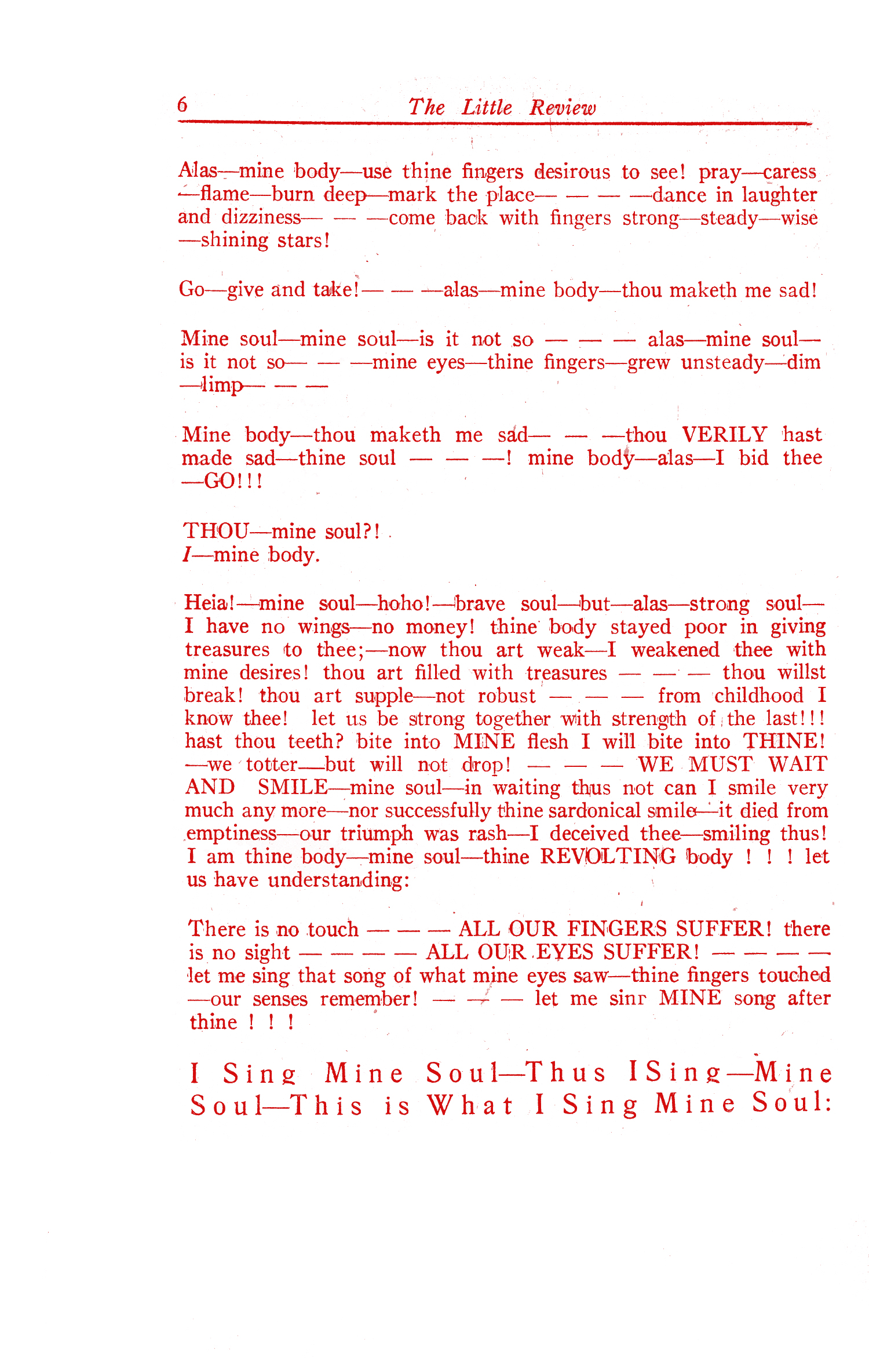
Mineself—Minesoul—And—Mine—Cast-Iron Lover
Letter to Robert Fulton Logan in 1917 and published in The Little Review, Vol. VI, September 1919, No. 5. New York: Margaret C. Anderson.
Samuel Vriezen is a composer and poet. Recent works include the chamber opera "What Happened/Plays" on text by Gertrude Stein; the VPRO radio play "Schade"; and the essay-book "Netwerk in eclips". He is a research supervisor at the Koninklijk Conservatorium and an editor at nY.
Samuel is preparing his lecture by Elsa in the context of the poetry and performance evening "Ah me! I don't perform". The vital poetics of Baroness Elsa von Freytag-Loringhoven which takes place on Friday March 27 in Perdu, Amsterdam.
Mathilde Strijdonk is a performance artist and studied Drama at KASK & Conservatory in Ghent. The work of Mathilde focuses on the emotional and empathic body. A breathable instrument in motion. This was also a crucial part of her performance SESSION, which she performed as part of Jong Werk op Theater aan Zee in 2017. In addition to performance, Mathilde is now also moving towards visual and video work.
Together with Stine Sampers and Naomi Schatteman she brought the Figures for Dashing performance in the BOEKS corridor. The performance will take place for a second time on March 27 in Perdu. More information.

6. The Dutch call me gedachtestreep—a dash of thought.
BOEKS—opening
thursday 12.12.19
19:00 - 22:00
20:00—Figures for dashing
Performance with Stine Sampers,
Naomi Schatteman
& Mathilde Strijdonk
Speaker: Brian Day
20:30—Thoughts on dashing
Talk with Peter de Voogd & Astrid Seme
BOEKS—exhibition
13.12.2019 - 06.03.2020
BOEKS—reading group
05.03.2020, 20pm, Kunstenbibliotheek
Baroness Elsa’s em dashes
2019
design and concept by Astrid Seme
published by Mark Pezinger Books & Kunstverein Langenhagen
No.1 of the Black Forest Library
10 × 14.5 cm, 88pp,
English, edition: 400
The publication is for sale at Kunstenbibliotheek for €13. Or in the BOEKS shop.
Published in connection with the exhibition "She Is The Future" in Kunstverein Langenhagen (09/12/18-03/02/19).
BOEKS 05:
Astrid Seme—Baroness Elsa’s em dashes
Baroness Elsa’s em dashes is an homage to the Dada artist and poet Elsa von Freytag-Loringhoven (1874 – 1927) and to her manic use of em dashes. Em dashes have different purposes—as an appropriation of silence, as acting dissonance, as interruption, as occupying space. In Elsa’s work, they seem to function more like performers between the words, creating movement and voice within the text. The exhibition places these performers in a real space, turning BOEKS into a performative venue.
Elsa’s em dashes will not just spread across the space, but they will become multiple voices inviting us to dash around. At the opening, the sound piece Figures for dashing will be interpreted by performers Stine Sampers, Naomi Schatteman and Mathilde Strijdonk. Afterwards, professor Emeritus of English Literature Peter de Voogd and graphic designer and sound artist Astrid Seme will try to put the dash into words. Together, we’ll send some Thoughts on Dashing into space.
Baroness Elsa’s em dashes is also the title of a book published in early 2019 by Kunstverein Langenhagen and Mark Pezinger Books, a Vienna & Black Forest-based publisher of artist’s books. They call it an anthology of dashing in print, poetry and performance. The reader will find Elsa’s works in conversation with well-known dashers such as Gertrude Stein, Laurence Sterne, Heinrich von Kleist or Emily “the dashing queen” Dickinson.



Alexandru Balgiu (Designing Writing) about Astrid Seme’s book Baroness Elsa’s em dashes:
A heart the thickness of a dash. I hold *Baroness Elsa’s em dashes* in my hand and hear the ticking of the Teke Heart. Elsa von Freytag-Loringhoven’s superb 1921 piece on the Beating of Heart comes to mind like a dash of thought, as I feel the book. Reading Astrid Seme’s wonderful anthology of dashing in print, poetry & performance is indeed an experience of pulsations: as I browse through the pages, a school of dashes animate in a playful dance in front of my eyes. One swiftly understands that *Baroness Elsa’s em dashes* is not merely a collection, it is an invitation. And it is not merely an observation, but also a proposition. Or rather, a series of pages propositions — remindful of Wittgenstein’s Tractatus — as the page numbers have left their paratextual position to lead the order of discourse, becoming the numbering of enunciations. *Baroness Elsa’s em dashes* counts to 81. Normal resting heart rates range from 60-100 beats per minute. The gesture of turning the page is an em-phasis of the progression of thought and — like the em-dash — marks “an appropriation of silence”. Astrid’s voice, in turn, is at once analytical and personal, weaving the typographic and the poetic with openness and proximity. Through these dashing propositions she unveils intersections (perhaps these em-dashes are not all so parallel, after all?) and explores cross-readings that prove — brilliantly — that neither design nor literature are monological, one-way roads, but rather myriad modalities for apprehending the subtleties and complexities of existence. Through radiant anecdotes, quotations and moving details, Astrid establishes contact. We get in touch with Baroness Elsa and Emily (Dickinson), and Heinrich (von Kleist), and Christian (Morgenstern), and Gertrude (Stein), and Lawrence (Sterne)… and it is now up to us to engage conversation and extend the dash, no matter how perceptible the thickness of line. Infrathin em-dashes? In Emily’s words:
A Murmur in the Trees — to note —
Not loud enough — for Wind —
A Star — not far enough to seek —
Nor near enough — to find —
At this point, Astrid would perhaps invite us to take a breath, as she does periodically throughout her publication, addressing us and calling on our own consciousness of the moment.
I, in turn, will urge you to meet her beautiful book.

01

02

03

04

05

06

07

08

09


10
11
01 Barones Elsa’s em dashes—Astrid Seme. (2019, Mark Pezinger Books). Photo: Arno Huygens.
02 Poster Design BOEKS 05: Myrthe Van Rompaey. Photo: Veerle Vervliet.
03 Opening BOEKS 05: Astrid Seme—Baroness Elsa’s em dashes. Photo: Zoë De Bock.
04 Figures for dashing
—Performance with Stine Sampers,
Naomi Schatteman & Mathilde Strijdonk. Speaker: Brian Day. Photo: Zoë De Bock.
05Figures for dashing.
06—07—08—09 Figures for dashing
—Performance with Stine Sampers,
Naomi Schatteman & Mathilde Strijdonk. Photo: Thomas Geiger.
10 BOEKS 05 collection on display in the Kunstenbibliotheek. Photo: Cato Vanrijckeghem.
11 Thoughts on dashing—Talk with Peter de Voogd & Astrid Seme. Video: Zoë De Bock.
12 BOEKS 05 corridor. Photo: Cato Vanrijckeghem.

12

Teke Heart (Beating of Heart), ca 1921. Source: The Little Review Records, University of Wisconsin-Milwaukee Libraries.
BOEKS reading group 03
mine soul—is
mine song to thee—
——thus its end
Thursday March 5th at 20:00
Kunstenbibliotheek
With this reading group, titled after the last sentence of the poem Mineself—Minesoul—And—Mine—Cast—Iron Lover by the avant-garde artist and poet Elsa von Freytag-Loringhoven, we conclude BOEKS 05: Astrid Seme—Baroness Elsa's Em Dashes. We gather in the Kunstenbibliotheek to read some of Elsa's poems, the dashes as well as the attached words.
BOEKS invited poet Samuel Vriezen and performer Mathilde Strijdonk to read a poem by Elsa. Samuel sketches a subjective portrait of Elsa, based on the aforementioned Cast—Iron Lover, published in 1920 in The Little Review. This nine-page love poem contains a dizzying number of dashes. The 450 dashes stand alone, form twins and triplets or coincide with words.
Mathilde brings Teke Heart (Beating of Heart) (ca. 1921) back to life. Heartbeats, red upper case letters and green dashes, dots and question marks alternate rhythmically. Together they form a complex, handwritten sound poem that cannot simply be read out. Rather, it appears before the eyes as an invitation to express letters and punctuation in different, self-completed ways.
Elsa regarded her dashes as “joy marks—like little shouts at the end of a line”, but in all their expressiveness they can be described in many ways. These dashes of thoughts have different purposes—as an appropriation of silence, as acting dissonance, as interruption, as occupying space. In Elsa’s work, they act out more like performers between the words, creating movement, color and voice within the text.
We further present the practice of the Baroness of DADA by referring to some quotes from the previously presented book Baroness Elsa's Em Dashes by Astrid Seme:
12. The ‘Baroness,’ Elsa von Freytag-
Loringhoven was an unstoppably innovative
sculptress, poet, and performance artist
working in and around the Berlin and
Munich avant-garde and New York Dada
during the dawn of the nineteenth century.
15. Elsa gained massive attention in New
York for her unique and daring sound poems,
unconventional use of punctuation,
and disregard for conventional syntax […]
44. Fiercely antibourgeois and antiestablishment
in tone, like the punk music she prefigures,
the Baroness’s verse is loud and demands
to be heard. Her poems are full not of sighs
but of yells, loud in their articulations
of the unutterable.
58. The Baroness wrote with the all-caps
setting on, and had a remarkable handwriting
style: neat, boxy, seemingly Bauhaus inspired
[…]
73. Jean Heap calls her “the first American
dada,” represents lived art: she is “the only
one living anywhere who dresses dada,
loves dada, lives dada.”

Mineself—Minesoul—And—Mine—Cast-Iron Lover
Letter to Robert Fulton Logan in 1917 and published in The Little Review, Vol. VI, September 1919, No. 5. New York: Margaret C. Anderson.
Samuel Vriezen is a composer and poet. Recent works include the chamber opera "What Happened/Plays" on text by Gertrude Stein; the VPRO radio play "Schade"; and the essay-book "Netwerk in eclips". He is a research supervisor at the Koninklijk Conservatorium and an editor at nY.
Samuel is preparing his lecture by Elsa in the context of the poetry and performance evening "Ah me! I don't perform". The vital poetics of Baroness Elsa von Freytag-Loringhoven which takes place on Friday March 27 in Perdu, Amsterdam.
Mathilde Strijdonk is a performance artist and studied Drama at KASK & Conservatory in Ghent. The work of Mathilde focuses on the emotional and empathic body. A breathable instrument in motion. This was also a crucial part of her performance SESSION, which she performed as part of Jong Werk op Theater aan Zee in 2017. In addition to performance, Mathilde is now also moving towards visual and video work.
Together with Stine Sampers and Naomi Schatteman she brought the Figures for Dashing performance in the BOEKS corridor. The performance will take place for a second time on March 27 in Perdu. More information.

03